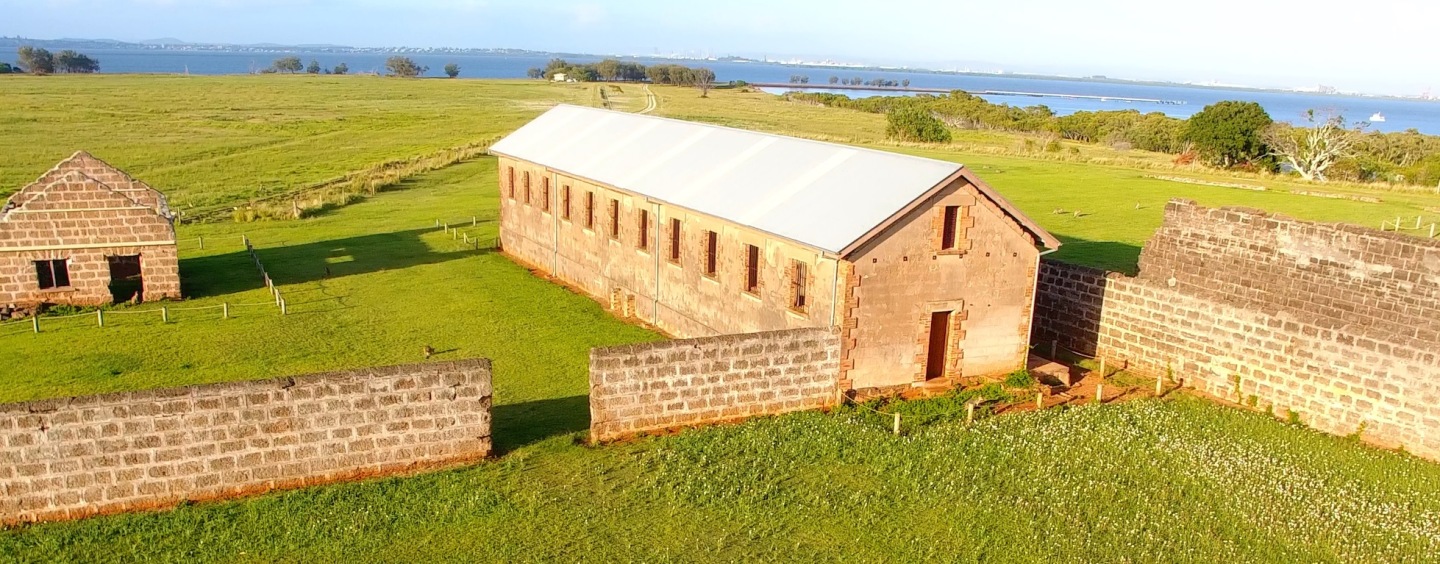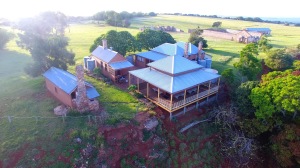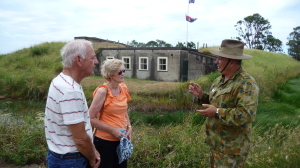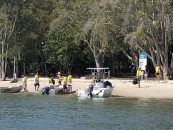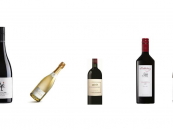Caroline Strainig discovers gold from our convict past when she sets out to explore off Wynnum-Manly.
St Helena Island
“What’s that? I can see some buildings on that island. Are they ruins?” I said excitedly to my friend, Richard. A quick glance at the marine guide and booklets we had picked up from the tourist information centre in Manly revealed the island was St Helena and the ruins were that of an old convict settlement.
One of the aspects I love the most about visiting somewhere new is the sense of anticipation. Today was one such day, our first outing in the runabout on Moreton Bay since moving to the area.
For us, finding convict ruins was sheer gold in terms of discoveries, and Richard immediately turned the runabout to starboard and headed for the anchorage near the jetty on the western side of St Helena. Ashore, the first thing we came across was a modern toilet block. Yes, useful if nature called. But where were the ruins? A short walk further on we encountered a convict graveyard and the remnants of an old lime kiln-like building. However, a fence and locked gate prevented us from accessing the main complex.
Research revealed you needed to join a guided tour to see the restricted area, and the following week we did just that. You have the option of joining a tour on a Wednesday or Sunday with a transfer by boat from Manly, or travelling to the island on your own boat and just joining in the island section of the tour, which costs only $30 a head. There are also several other tour options, including night “ghost” tours.
The island has a fascinating history. Initially, it was a quarantine station, but it was turned into a high-security colonial prison in 1867 because of overcrowding in Brisbane’s gaols. Seven per cent of the original penal settlement remains, mainly that made of beachrock or brick, plus a caretaker’s cottage built in the 1900s that has been turned into a museum. While idyllic now, back then it must have been a living hell for the inmates, who had to toil long days at farming or a trade, and live in cramped conditions on a diet that was cringingly unhealthy by modern standards.
The guides, all skilled actors from a theatre troupe, helped bring the convict history alive by dressing as convicts and staging a mock flogging, much to the delight of the children on the tour. One of the guides told us many people do not discover the island until they have lived in the area for half a life-time. “It’s Brisbane’s best-kept secret,” he said.
Thankfully, many schools are now including a visit to the island as part of their curriculum so this is changing with the new generation.
Caretaker’s Cottage (now the Museum).
Photo courtesy NPWS
Fort Lytton
A few weeks later, we discovered more gold. This time, it is of a military nature, just a short distance to the north-west on the southern bank of the Brisbane River.
The Fort Lytton Historic Military Precinct is a heritage-listed 1880s coastal fort, complete with gun emplacements and a moat. It was operational through the Boer War, World Wars I and II, and the Korean War.
Today, Fort Lytton is a national park, open to the public on most Sundays and some public holidays, when Queensland Parks and Wildlife Service (QPWS) rangers and a non-profit volunteer organisation offer tours. There are also battle re-enactments every winter.
You can still see some of the original fort, including guns painstakingly restored. Many of the buildings in the surrounding military precinct are also intact and some of them are used to showcase military equipment and uniforms from different periods. For my partner Richard, who is ex-RAAF, it was a wonderful trip down memory lane.
You can access the fort by road from the Brisbane suburb of Lytton, or via the water from a public jetty on the Brisbane River. The QPWS can make ranger tours available to people who visit in their own boats on some weekends, but you must book in advance. The jetty is locked to the public outside these times and the fort inaccessible from the water. You also need permission from the Brisbane Port Authority because of shipping traffic on the river.
You can do a guided tour of Fort Lytton for a donation.
Photo by Caroline Strainig.
So, there you have it – two wonderful historic destinations to add to your must-visit list next time you head up this way, whether by boat or car. Don’t wait 30 years to discover them. Enjoy!
————–
FACTS AND FIGURES
St Helena
St Helena is located five kilometres from the mouth of the Brisbane River and eight kilometres north-east of Manly. GPS: 27°23’36″S 153°13’54″E
The public may use the jetty to disembark and board passengers, but the vessel may only be tied to the jetty if the skipper remains on board; otherwise, the vessel must be anchored away from the jetty.
History: npsr.qld.gov.au/parks/st-helena-island
Tours: sthelenaisland.com.au
Fort Lytton
Fort Lytton is located on the southern bank of the Brisbane River, 14km from the Brisbane CBD. GPS: 27°24’44″S 153°09’00″E
The jetty can only be used by prior arrangement with the rangers on some weekends if you book a tour in advance – for more information phone 07 3393 4647.
History: npsr.qld.gov.au/parks/fort-lytton
Tours: fortlytton.org.au
Getting there
If traveling from the Gold Coast to Brisbane, you may refer to the article Gold Coast to Brisbane by Nic Welch published in Boat Gold Coast May 2016 edition. https://boatgoldcoast.com.au/gold-coast-to-brisbane/
/Sep-Dec2017






















